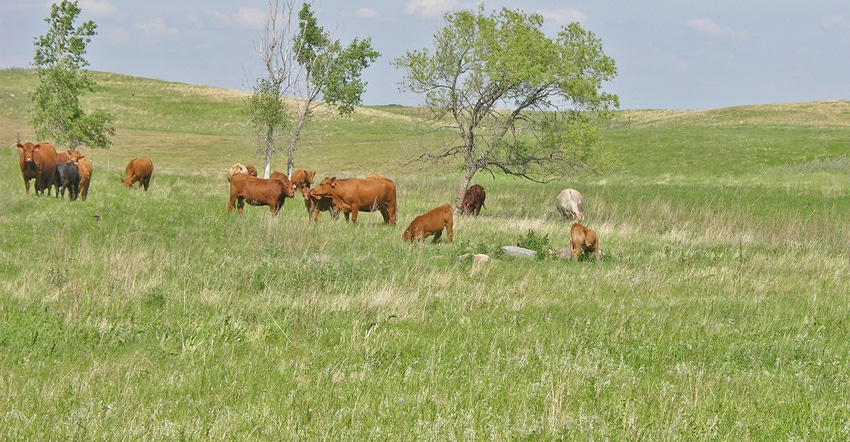Service helps predict pasture grass health
Livestock producers who want to know what feed they’ll have available can turn to this new service.

Just how much grass will those pastures produce this season? For livestock producers, this is a question worth asking, but finding the answer has been tough. For Northern Plains producers, a new online tool could help. Under development for the past few years, the new Grassland Productivity Forecast, or Grass-Cast, is now available.
“Our motivation for this product is livestock producers who rely on summer grazing,” says Dannele Peck, director of the USDA Northern Plains Climate Hub, Fort Collins, Colo. “Ranchers face the challenge of looking around every spring, wondering how much grass might grow on their rangelands and native pastures.”
Answering that question can help producers decide how much livestock to keep, whether adding or culling might be necessary, or if buying hay will be needed. Peck says Grass-Cast aims to provide a forecast of pasture or rangeland production potential based on several factors.
Building a forecast
This new tool combines weather data and grassland modeling, and was built through the cooperation of university and USDA researchers in Colorado, Wyoming, Nebraska and Arizona. Grass-Cast takes known weather from past years and recent months and combines it with predicted rainfall for the growing season to develop a forecast for how well pastures should grow.
“When we created the model, we focused first on a handful of sites in the Northern Plains where there is long-term data,” Peck says. “There was 40 or more years of information for two things: what the weather was like, and how much rangeland vegetation actually grew out there each year.”
For those long-term sites, Peck says researchers clipped rangeland vegetation and weighed it to determine production. This is a critical data set for building the Grass-Cast model.
For areas where no long-term clippings data exists, the next best substitute is satellite data for the region. Peck explains that the satellite data (known as the Normalized Difference Vegetation Index) goes back about 15 years, and measures the green-ness of the landscape at the peak of the growing season. “We have satellite data for every county that Grass-Cast covers,” she adds.
That satellite data for every county, when combined with the in-field long-term clippings data and historical weather information, provides solid building blocks for an effective model. The final piece needed is a decent prediction of precipitation during the growing season, which is provided by the National Oceanic and Atmospheric Administration.
With these data points, the model can go to any county in the region and estimate the pounds per acre that a pasture should produce, Peck says.
Model challenges
But turning the Grass-Cast model into a useful map for producers wasn’t easy, because weather changes quickly and the NOAA’s seasonal precipitation outlook gets updated monthly. Grass-Cast will be released twice per month throughout the season, incorporating new observed weather data and NOAA’s updated prediction. However, last year’s rapidly emerging drought in the Northern Plains gave the pasture modelers added pause in how to present their information.
“We had to think more carefully about what maps to put out there for people to see,” Peck says, “because even the most cutting-edge forecasts are sometimes wrong. So we decided to release a set of three Grass-Cast maps. You can view those three maps side by side to get a better feel for the range of outcomes possible for a specific county.”
The three maps — as shown below — show how well rangeland vegetation should grow if precipitation over the rest of the growing season is above-normal, near-normal or below-normal. A note appears under the maps saying if the NOAA’s seasonal precipitation outlook suggests one map is more likely than another, or if they are equally likely.
 REPORT REVIEW: The report offers a look ahead for three scenarios: above-normal precipitation (left), normal precipitation and below-normal precipitation. This is a planning tool for livestock producers.
REPORT REVIEW: The report offers a look ahead for three scenarios: above-normal precipitation (left), normal precipitation and below-normal precipitation. This is a planning tool for livestock producers.

Grass-Cast provides one more tool for ranchers when deciding how much livestock to put out, or which counties might have some extra forage to graze. These maps are from May 21. Updated maps can be found at grasscast.agsci.colostate.edu.
Peck points to counties in southeastern Colorado in the May 21 maps. “In some of those counties, no matter how much precipitation they get in June and July, our model says pasture production will probably be below-normal,” she says. “But in parts of Nebraska, no matter how much precipitation they get, they should have near- or above-normal pastures.”
How does this help a rancher? This is information you didn’t have before as part of your risk management plan. If you’re in an area where, even with above-normal rains pastures will underperform, you know you have a couple of choices: cull cows or buy hay. For producers in areas where it looks like pasture will be lush, you may want to consider putting on a few more cows.
Peck says the project is a “marvelous example of multiple institutions working together across state boundaries.” The primary science work behind the model started at Colorado State University in partnership with USDA’s Agricultural Research Service. There was involvement by colleagues at the National Drought Mitigation Center in Nebraska, and work on the remote-sensing portion by an expert at the University of Arizona, as well. The group also partnered with USDA’s Natural Resources Conservation Service, whose rangeland scientists are being trained to use the information.
Livestock producers may want to bookmark the Grass-Cast website, grasscast.agsci.colostate.edu, and check the maps every two weeks.
About the Author(s)
You May Also Like



